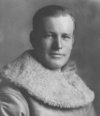
|
|
LET THERE BE LIGHT
by Red Kelso
![]()
|
Over a nine month period, a necklace of rotating beacons was established between Chicago and Cheyenne. It came to a total of 324 airway lights for approximately 1,100 miles. The project also wired boundary lights for terminal fields, emergency landing strips and powerful beams marking terminals at about five major airports. You could say the rotating beacons were color-coded: red flashes for dangerous hills, obstruction and unsafe terrain. Not all the beacons were the same size. They ranged from 24 to 32 inch reflectors and put out different candle power. They were bight enough that pilots could see them 50 to 70 miles away, in good weather, that is. The
beacons were also a great navigation aid in bad weather. The lights were calibrated so that if a pilot could see the entire light, he was high enough to clear any obstacle. If only a portion of the light could be seen, he was too low and had better get another hunk of altitude under him. The establishment of an airway beacon and the accompanying landing strip made the local newspapers. In cruising though copies of the local papers of 70 to 75 years ago, the communities seemed proud to have a U.S. Air Mail facility in their backyards. Powering the light systems was also very interesting. The Post Office Department would use local electric power if it was available. Otherwise, butane tanks were spotted near a beacon for gas firing. Another method used a wind driven generator charging heavy duty wet cell batteries. Many of the locations had caretakers who would daily check the operation of a site. Where possible, a "sun switch" would automatically turn off the light during daylight and turn it on at dusk. Meanwhile, 24 DHs were equipped for night flying. Navigation lights were installed on wing tips and tail, red for the left wing, green for the right wing and white for the tail. The same lighting system is used today. Landing lights were also installed on each wing tip. Maybe it was during this period of aviation when the old pilot’s adage was born: "If you are making an emergency landing at night and don’t like what you see, turn off your landing light." In 1924 and 1925, the lighted airways were extended east from Chicago to Cleveland and New York and west from Cheyenne through Rock Springs, Wyoming, to Salt Lake City and then on to San Francisco. The last two airway extensions were extremely difficult because of the Allegheny Mountains on the west side and the Laramie and Wasatch Ranges of the Rock Mountains on the west. It’s tough to place an emergency field or a beacon on a mountain top. By the end of 1925 at the cost of nearly $545,000, the U.S. Air Mail truly had a day and night transcontinental airmail route covering a distance of slightly over 2,000 miles from New York City to Salt Lake City. |
History |
Air Mail Pilots
|
Photo
Gallery |
Flight Info
|
Antique Airplanes
|
Members |
|
copyright © 1999 Nancy Allison Wright, President Air Mail Pioneers
|
 When
"Slim" Lewis landed his de Havilland at Cheyenne on the night
of July 1, 1924, it triggered the end of the U.S. Air Mail’s nightly
railroad trip and marked the beginning of regularly scheduled night
airmail. It was a quiet undertaking. There was a demand by
businessmen, corporations and other commercial outlets that wanted same
day service, and the Post Office Department wanted it to happen.
When
"Slim" Lewis landed his de Havilland at Cheyenne on the night
of July 1, 1924, it triggered the end of the U.S. Air Mail’s nightly
railroad trip and marked the beginning of regularly scheduled night
airmail. It was a quiet undertaking. There was a demand by
businessmen, corporations and other commercial outlets that wanted same
day service, and the Post Office Department wanted it to happen.